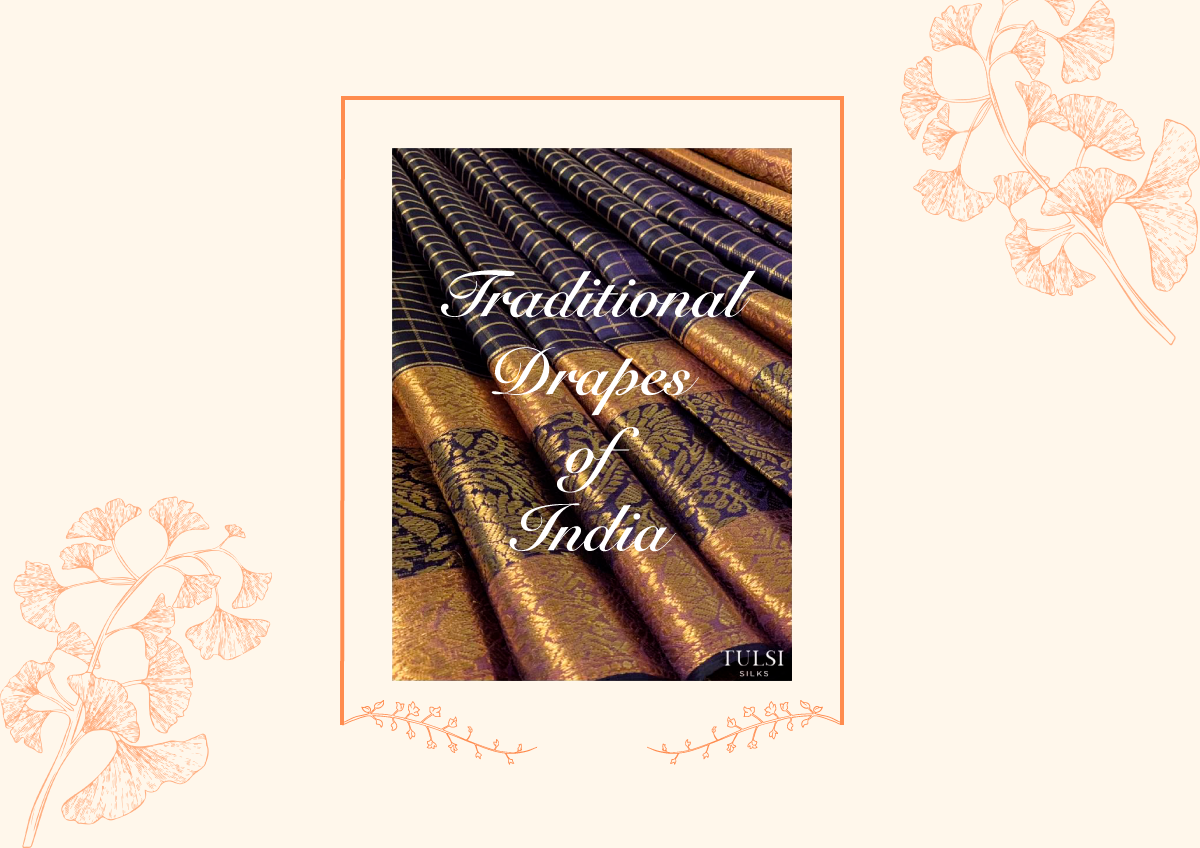Types of Traditional Saree Draping Styles from Different States in India
India is a diverse land known for its rich cultural heritage and traditions, each with its faith, food, dress and rituals. One common tradition that Indians can take pride in is the saree. India is known worldwide for its variety of sarees made using different fabrics and methods. Sarees can be draped in different styles, and each drape has a significant history. In this blog, we will take a journey down the history of India's different saree wearing types and draping styles.
Types of Different Styles of Saree Draping in India
1. Madisaru Saree Drape from Tamil Nadu
The Madisaru saree or also known as the Kosavam saree is worn by women in Tamil Nadu, especially Brahmin women. This style of draping the saree dates back as far as the 2nd century BC. Different Tamil communities drape the original Kosavam style in different ways. Madisar drape is of two styles: the Iyer and the Iyengar kattu (tie). Usually, the Madisar saree is draped using a nine-yard saree like the Nauvari sarees.
Source: Pinterest
2. Coorgi Saree Drape from Karnataka
Women wear the Coorgi style saree in Karnataka. It is worn with a matching head scarf. Also known as the Kodagu saree, the pleats of the saree are tucked at the back and the pallu of the saree is draped under the left shoulder and secured over the right shoulder, called the molakattu. Coorgi saree has a mythological origin and suits the lifestyle of Coorgi women helping them climb up and down the slopes of the hilly region. The Brides of Karnataka drape Kanjivaram sarees in Coorgi style.
Source: Pinterest
3. Nivi Saree Drape from Andhra Pradesh
The Nivi drape is a regional saree draping style from Andhra Pradesh and is one of the popular and modern saree drapes among women across the country. The Nivi drape involves tucking the pleats at the centre of the waist, and the pallu is draped from the right and is pinned to the left shoulder. The Nivi drape allows for easy movement and is perfect for women who are constantly on the go.
Source: Tulsi Silks
4. Nauvari Saree Drape from Maharashtra
Nauvari saree also called the Kasta saree hails from Maharashtra. This Marathi-style saree is draped using a nine-yard saree and hence the name Nauvari. Popularly worn by Marathi women, the drapes of the Nauvari saree feature dhoti style drapes and the pleats are tucked at the back. Nauvari sarees are worn without the petticoat and are known as Akanda Vastra which means they do not need other clothing to support them. It allows free physical movement, women have even fought wars and have worked on the soil wearing them.
Source: Pinterest
5. Mundum Neriyathum Saree Drape from Kerala
Mundum neriyathum is the Kerala traditional saree. Mundum neriyathum just like the words is a two-piece clothing, mundu referring to the lower garment and neriyatu upper garment. The mundu is draped around the waist and is the ancient form of the saree, and the neriyathum is worn over a blouse diagonally from the right hips to the left shoulder. It is traditionally white or cream with a coloured border. Some have a broad gold zari border worn for festivals and weddings, which is also known as the Kasavu saree, one of the Kerala style saree.
Source: Pinterest
6. Pin Kosuvam Saree Drape from Tamil Nadu
Pin Kosuvam saree is another traditional saree worn by women from Tamil Nadu. The word ‘pin kosu’ means the pleats at the back. The saree is draped around the waist half-time more than the general drape and the pleats of the saree fall outside the drape in the traditional saree look. The pin kosuvam saree draping is suitable for the hot weather of Tamil Nadu and handloom cotton sarees are preferred as the underside is visible in this drape.
Source: Pinterest
7. Seedha Pallu Saree Drape from Gujarat
Seedha Pallu is a traditional draping style that can be seen in the states of Gujarat, Uttar Pradesh, and Odisha is draped uniquely with the pallu in the front. The Gujarati style saree drape is considered to be popular throughout the country and is worn by women of other states for special occasions. This style is worn from light fabric saree like Georgette and Chiffon to heavy fabric sarees like Banarasi and Kanjivaram.
Source: Pinterest
8. Atpoure Saree Drape from Bengal
Atpoure or popularly known as the traditional Bengali saree is worn by women of West Bengal in India and Bangladesh. The distinctive drape of this saree is the pleats and the pallu on both shoulders. Traditional Bengali style saree is white in colour with a red border. Traditionally and even today women who are head of the household tie a bunch of keys to the pallu on the right shoulder. During Durga Puja, women can be seen wearing the saree with a bright red bindu that makes them even more beautiful.
Source: Pinterest
9. Mekhela Chador Saree Drape from Assam
Mekhela Chador is a treasure from the Indian state of Assam. Assamese handwoven sarees are worn using this style and they are usually passed down for generations. Mekhela Chador saree drape involves two parts: mekhela the bottom part of the saree with criss-cross pleats and the chador which covers the upper torso and is draped like a saree.
Source: payalchadha.com
10. Halakki Vokkaliga Saree Drape from Karnataka
Halakki Vokkaliga is the native of the Western Ghats of Karnataka and the women wear this style of saree which has a unique drape involving a number of pleats. Most of the saree is pleated in sections and tucked in at the waist and then the saree is draped on the upper body and taken under the shoulder to the back and is knotted on the right shoulder using the pallu at the front and the end of the saree at the back.
Source: Pinterest
11. Kappulu Saree Drape from Andhra Pradesh
The Kappulu saree is a traditional saree worn by women of the Kappulu caste from the southern Indian state of Andhra Pradesh. The Kappulu saree unlike the normal style is draped from the left to right. The draping style of the Kappulu saree involves pleating the saree in a specific way to create a series of folds and loops around the waist. The saree is then wrapped around the body once, and the pleats are tucked in at the waist.
Source: Pinterest
12. Kunbi Saree Drape from Goa
The Kunbi saree is named after the ancient tribe of Goa. The Kunbi saree is a checkered saree that is prominently dyed in shades of red. Kunbi saree is traditionally worn without a blouse and draped across the waist and tied on the right shoulder. These sarees were worn until the knees usually by women who worked in paddy fields. It is rare to see women draping the Kunbi saree as this type of weave has declined in the past decade.
Source: Pinterest
13. Dhangad Saree Drape from Goa
The Dhangad saree, also known as the shepherd's drape is popularly worn by women in North Goa. The saree is worn without a petticoat, it is draped by tying a knot at the waist and pleated like the basic saree drape and the pallu is worn over the left shoulder. Then the lower part of the saree is taken from the front to back forming a dhoti style and the pallu is tucked at the waist in the front. The saree is also worn by tucking it on the side of the waist on both sides and the remaining at the back so it comes to knee length making it easy for women to work.
Source: stylecaret.com
14. Parsi Saree Drape
The women of the Parsi community in Gujarat, Mumbai, and Kolkata wear the Parsi drape. It is also known as the Gol saree, the pallu is draped from the back to the front on the right shoulder and is taken diagonally to the left shoulder similar to that of the Seedha Pallu drape. This drape is not only worn in India but by the Parsi community across the world.
Source: oyepg.tmblr.com
15. Gochi Kattu Saree from Telangana
The Gochi Kattu saree is a traditional saree drape from rural Telangana. The Golla shepherd community women wear this saree style and today older women in rural areas of Karimnagar, Nizamabad, and Adilabad can be seen wearing this saree. This saree drape is similar to the Nauvari drape as it has the dhoti style drape allowing women to work freely in the fields. Navvar sarees made of cotton are used for the Gochi Kattu drape.
Source: thesariseries.com
Conclusion
We saw a number of different types of Indian saree draping styles wear that belong to different states, but these are only a few of them and there are a lot more drapes that are not popular as the ones on this list. You can try out some of these saree draping styles to break from your regular style and also have fun!
If you are someone who loves sarees then you should check out Tulsi Silks’ authentic silk collections of Kanjivaram, Banarasi, Tussar silk, Chaniya silk, Mysore silk, Soft silk, Uppada silk, Kani silk, Gadwal silk, Ikat silk and the trendy collections Georgette, Chiffon, Linen, Crepe and Organza. Visit our website or offline store and add a part of our heritage to your wardrobe.
Read our other blogs to know everything about sarees and how to style them.




